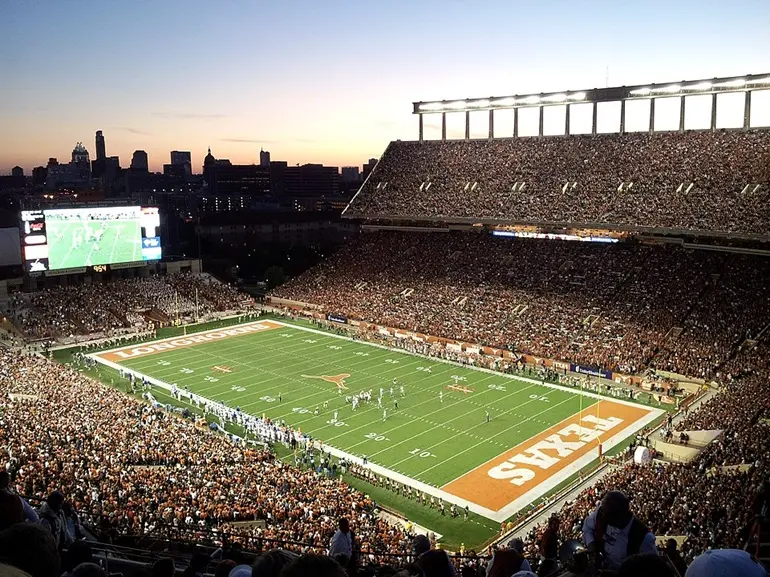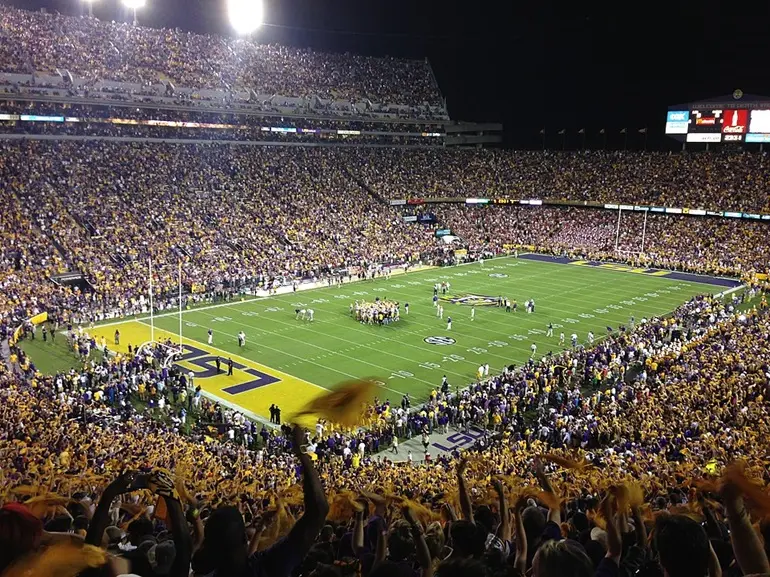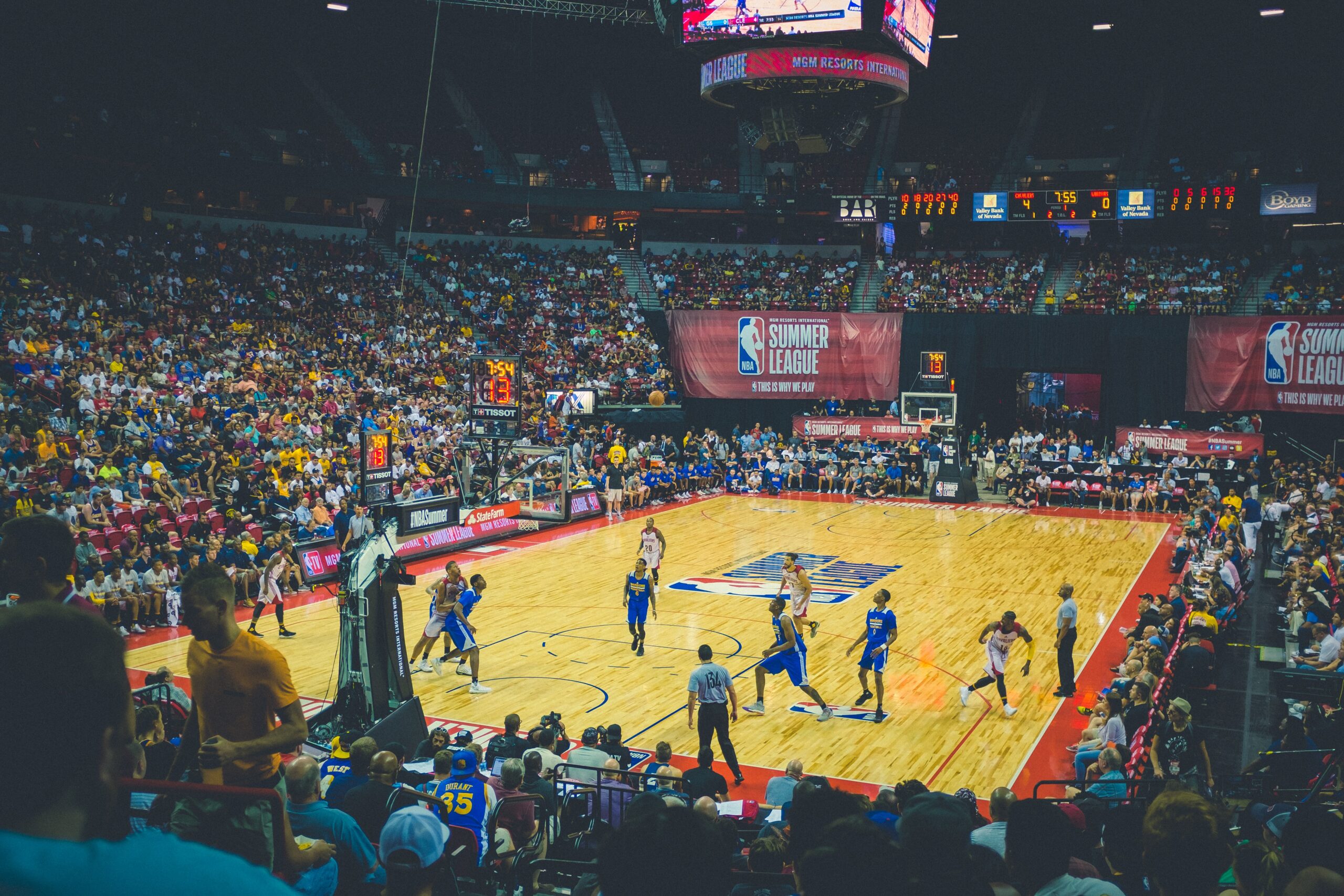It won’t take fans of football to notice that not all football stadiums are created equally. As a matter of fact, most college football stadiums are quite a bit bigger than their NFL stadium counterparts. But why is that? Why are college stadiums bigger than NFL stadiums?
As it turns out, there is quite a bit more involved than simply bigger fan bases. There are millions of college football fans as well as fans of NFL teams. Let’s look into why many of the top college football stadiums dwarf popular NFL stadiums.
Ticket Pricing and Stadium Size
Perhaps the biggest advantage that college football stadiums have is ticket pricing. To put it simply, NFL tickets are expensive. Really expensive. Historically, the largest stadiums were created to appeal to greater demand.
At a larger university, like Michigan or Texas, there can be tens of thousands of students flocking in each year. Students usually get an allotment of free tickets, so that already takes up a huge chunk of seats. More popular teams will also have alumni and fans travel for games. That creates an even larger demand for seats.
As tickets at NFL stadiums have gotten more expensive, the cheaper college football ticket prices become a major factor. College football fans can go to more games without breaking the bank than your average NFL team. As a result, major college football programs will outdraw NFL teams on a regular basis.
Impact of NFL Blackout Policy
The NFL’s blackout policy also goes hand in hand with the size of NFL stadiums, like the Empower Field at Mile High. If that doesn’t make sense, it will in a minute. The NFL signs off on television deals every few years that pay out millions in television licensing money. That said, there are blackout restrictions if games don’t sell out.
Simply put, it is a way for the NFL to ensure that the crowd in attendance will be at capacity. The average NFL stadium features luxury boxes and club seating for two reasons. For one, they make more money than simply adding more seats. It also means bringing enough people into the house to sell out and avoid those blackout restrictions.
Filling in the stadium is not a matter of getting as many fans into the stadium as possible. With college football, there is no worry about blackout restrictions. Most major sports have these restrictions, but college sports allow many schools to get television time without that threat.

Geographic Factors in Team Distribution
Location is an incredibly important part when talking about football stadiums and their capacity. Sure, larger demands require the largest stadiums, but it isn’t as simple as that. Let’s take a look at both college football stadiums and NFL stadiums.
Let’s take a look at one of the biggest college football stadiums out there: Michigan Stadium. Known as the Big House, Michigan Stadium seats more than 107,000 fans. It is one of the biggest stadiums in all of sports. It is able to reach capacity each week for a couple of reasons. Cheaper ticket prices, thousands of students, and a rabid fan base both in Michigan and from beyond.
College football stadiums are often far easier to fill at that capacity than an NFL stadium because of those travel benefits. Fans like going to football stadiums but they generally don’t want to go out of the way to do so. Combined with cheap college football tickets and it is easy to see what the crowd prefers.
Stadium Design and Historical Significance
Here’s another factor to consider when thinking about football stadiums. Many of the largest stadiums in college football were created decades ago. The vast majority of college football stadiums have history to them (and older designs).
These days, NFL owners are demanding new stadiums all the time. Take the Buffalo Bills, for example. Theirs won’t be the largest stadium, but a new stadium will come with more luxury boxes, tickets that cost more, and a chance to make more money. Sports, after all, is mostly about that these days.
The biggest stadiums in college football – like Michigan, Texas, Oklahoma, Ohio State, etc. – have more seats and are appealing to students and fans alike. With cheaper ticket prices and an appeal to tradition – not to mention the unique college football environment each Saturday – it becomes apparent why so many prefer the college football experience (and the cheaper seat) to the much more expensive NFL stadium,
There is one factor that NFL events have over college football and that is comfort. It might be a costlier seat, but the average NFL stadium now comes equipped with unique food options, free Wi-Fi, huge team shops, and more. The cost for the crowd might be more but it certainly is elevated over even the biggest football stadiums in college.
Notable College Stadiums
Which program takes the title for the largest stadium in the country? As it turns out, there are 14 different programs that have a larger capacity than the biggest stadiums in the NFL.
Michigan – Michigan Stadium
The biggest stadium in all of American sports. With a capacity of 107,601, the Wolverines pack in more than a million fans each college football season to see the Maize and Blue contend for a national title.

Penn State – Happy Valley
Beaver Stadium is just 1,029 fans short of matching the Big House for attendance. That said, “Happy Valley” is one of the toughest places in all of college sports to play. The whiteout of more than 100,000 fans is intimidating for any college program.

Ohio State – The Horseshoe
More than 100,000 (102,780) flock to Columbus every Saturday to see the Buckeyes play. The Horseshoe has become a must-visit for football fans, not even just college football fans. The Scarlet and Red fanbase is among one of the most raucous as well.

Texas – Darrell K Royal-Texas Memorial Stadium
There is nothing quite like Longhorn Football. Darrell K Royal-Texas Memorial Stadium packs in 100,119 each Saturday in what has become akin to a religious experience. Hook ‘em Horns are thrown up by a sea of Longhorns fans.

LSU – Tiger Stadium
Few college stadiums are as intimidating as Tiger Stadium, aka Death Valley. The Bayou is one of the most unique venues in college football and the stadium literally shakes at times.

Influence of School Pride on Stadium Size
You may think that the diehards of an NFL team are hardcore fans, but they are nothing compared to school pride. There are thousands of students attending the university each year but that is just a drop in the bucket as to the size of a fan base.
Take some of the bigger college fanbases out there. Michigan, Texas, Ohio State, and others already have thousands of students and millions of alumni around the country. Those alumni are more than willing to travel to major games, both on the road and at home.
There largely is not that sense of fervor attached to NFL games. Fans probably aren’t going to travel very far for the average NFL regular season game. That’s not even mentioning the intense school pride that exists in many college football fanbases. The bigger the program, the deeper that sense of school pride runs.
Let’s go back to Ohio State, for example. Fans of the Buckeyes football program don’t even necessarily have to be football fans. Former athletes from other sports in the program will support the football team because it is part of the school. That is something that does not exist when it comes to the NFL and other professional sports.
The Role of Fan Proximity and Alumni
Proximity is a major difference when comparing college football stadiums and their NFL counterparts. A significant number of NFL stadiums are located in downtown areas. Traveling in that kind of traffic can be a frustrating experience. For those who live a good distance away, going to a game can feel like an impossibility.
In college football, you don’t have to have the largest stadium to draw a crowd. Students and alumni often don’t have to go very far from campus to attend a game. There is less of a need to search for parking, especially for those who can simply walk to the stadium.
Speaking of alumni, that plays a massive role in football stadium sizes. Let’s go back to Michigan Stadium. The Wolverines have one of the largest alumni bases in all of college sports. The Buckeyes out of Columbus might be even bigger. With millions of alumni, the demand is there almost no matter who the opponent is.
With a larger fan base, especially locally, schools are able to keep costs down per seat. Getting people into the building then becomes easier since everything is so much more affordable. That is one of the best aspects of attending college sports.
The Future of Stadium Design in Football
It is hard to know what the future of college stadiums might be in the USA. America, especially Texas, has an affinity for “bigger is better” but it is hard to get much bigger than the kind of capacity that college programs are pulling in these days.
Will we see college stadiums turn into state-of-the-art venues like each new NFL stadium? It already appears that football stadiums in the NFL are moving into a sleeker, more modern design. The goal is to appeal to the fan experience on the whole rather than the product on the field.
For now, college stadiums will continue to have the edge in capacity and tradition. Millions of students and fans flock to watch college football every Saturday, creating perhaps the most unique environment in sports. Part of that is only because of the specter of these huge venues on campus.












